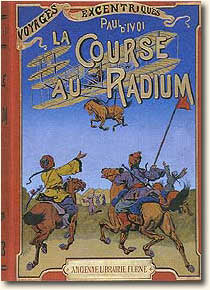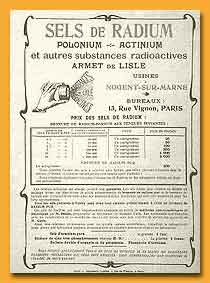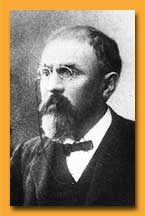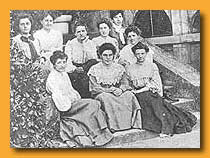 |
| “The Race for Radium.”
The public was fascinated by radium. In cheap science fiction
novels--and sometimes in sober newspaper articles--it was touted
as a magical substance whose rays could cure all ills, power
wondrous machines, or destroy a city at one blow. (Photo ACJC) |
|

|
|
“Radium Salts/Polonium - Actinium/and
other radioactive substances.” An announcement and price
list for materials produced by Armet de Lisle's factory. Although
fabulously expensive, the materials were much in demand for
attacking cancer, skin diseases and other ailments. (Photo
ACJC)
READ
Curie's words
|
|
|
 THRIVING INDUSTRY based on the “miracle” drug radium
soon grew up, however, and it was tightly linked with the Curies.
Pierre's pioneering work on the effects of radium on living organisms
showed it could damage tissue, and this discovery was put to use against cancer
and other ills. In 1904 French industrialist Armet de Lisle, whose
factory would soon provide radium to the medical profession, began
to collaborate with the Curies. De Lisle benefitted from the Curies'
technical suggestions on the best treatments for pitchblende. In
return the Curies were able to accumulate larger samples of radioactive
material than they would have been able to prepare on their own.
At a time when few research posts were available in France, de Lisle
also provided jobs in the new radium industry for a number of scientists
who had trained with the Curies.
THRIVING INDUSTRY based on the “miracle” drug radium
soon grew up, however, and it was tightly linked with the Curies.
Pierre's pioneering work on the effects of radium on living organisms
showed it could damage tissue, and this discovery was put to use against cancer
and other ills. In 1904 French industrialist Armet de Lisle, whose
factory would soon provide radium to the medical profession, began
to collaborate with the Curies. De Lisle benefitted from the Curies'
technical suggestions on the best treatments for pitchblende. In
return the Curies were able to accumulate larger samples of radioactive
material than they would have been able to prepare on their own.
At a time when few research posts were available in France, de Lisle
also provided jobs in the new radium industry for a number of scientists
who had trained with the Curies.
Although their collaboration
with industry advanced their scientific endeavors, the Curies did
not grow wealthy as a result. With a child and a parent to support,
household help to pay for, and an expensive research project to
carry out, Pierre sought a job with better pay. The product of an
unorthodox educational background, he found no welcome at French
universities.
“...we
were forced to recognize, toward 1900, that some increase
in our income was indispensable.”
|
|
| Then the
University of Geneva made an offer that included not only a good salary
but also an adequate private lab in which Marie would play an official
role. The threat of losing Pierre to Switzerland energized the French
establishment. Thanks to the intervention of French mathematician
Henri Poincaré, Pierre got the chair of physics in a Sorbonne program
that introduced medical students to the basics of physics, chemistry,
and natural history (and thus called PCN). |
 |
| Henri Poincaré was one of
the senior scientists who admired the Curies' work, and steered
jobs and monetary awards their way. |
|
 |
| Irène points to her mother's
radiation-scarred fingertips (Photo ACJC) |
|
 New
Responsibilities and Concerns
New
Responsibilities and Concerns
 O
LAB WAS PROVIDED with Pierre's PCN position, so the Curies maintained
their lab at the shed. Although Pierre's salary rose, his teaching
load doubled, since he kept his position at the Municipal School
also. The Curies noted the subsequent deterioration in his health.
They failed to consider a possible link between Pierre's attacks
of severe pain and the intense radiation they were working with.
Marie herself had lost nearly 20 pounds while doing her thesis research,
and both Curies did permanent damage to their fingertips from their
unprotected exposure to highly radioactive materials. O
LAB WAS PROVIDED with Pierre's PCN position, so the Curies maintained
their lab at the shed. Although Pierre's salary rose, his teaching
load doubled, since he kept his position at the Municipal School
also. The Curies noted the subsequent deterioration in his health.
They failed to consider a possible link between Pierre's attacks
of severe pain and the intense radiation they were working with.
Marie herself had lost nearly 20 pounds while doing her thesis research,
and both Curies did permanent damage to their fingertips from their
unprotected exposure to highly radioactive materials.
|
| Anxious
to contribute to the family income, Marie became the first woman to
be appointed lecturer at France's best teachers' training institution
for women. Located in the Paris suburb of Sèvres, the school had a
distinguished group of professors from the Sorbonne and elsewhere.
Marie was the first instructor there to include laboratory work in
the physics curriculum. |

|
| It took Curie, shown here
with some of her students at the Sèvres college for teachers,
a full year to figure out the appropriate level for effective
teaching. (Photo ACJC) |
|
“I
had to give much time to the preparation of my lectures
at Sèvres, and to the organization of the laboratory work
there, which I found very insufficient.”
|
 EALTH
AND FINANCIAL CONCERNS were not the only problems to plague
the Curies as Marie wound up her thesis research. Although in the
course of her thesis work the prestigious French Academy of Sciences
had recognized Marie's scientific promise by awarding her a prize
on three occasions--and such prizes could be a significant source
of income for researchers--the academy dealt the Curies a blow by
denying membership to Pierre in 1902. At about the same time Marie's
beloved father died in Poland following a difficult gall bladder
operation. EALTH
AND FINANCIAL CONCERNS were not the only problems to plague
the Curies as Marie wound up her thesis research. Although in the
course of her thesis work the prestigious French Academy of Sciences
had recognized Marie's scientific promise by awarding her a prize
on three occasions--and such prizes could be a significant source
of income for researchers--the academy dealt the Curies a blow by
denying membership to Pierre in 1902. At about the same time Marie's
beloved father died in Poland following a difficult gall bladder
operation.
� 2000 -
American Institute of Physics
|
|

